< Circuit Theory
Some very complicated circuits can be solved by seeing symmetry. Three examples are presented below:
Example 1
Bridge Balance
 Original Complicated Circuit
Original Complicated Circuit Redrawn up and down
Redrawn up and down Z impedances are all equal, so middle Z has no current going through it, nodes on either side are at the same EMF
Z impedances are all equal, so middle Z has no current going through it, nodes on either side are at the same EMF middle Z can be replaced by short or open, since no current is going through it
middle Z can be replaced by short or open, since no current is going through it
Example 2
Cube
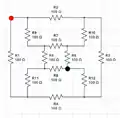 original flattened cube of resistors
original flattened cube of resistors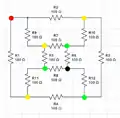 identifying identical EMF locations
identifying identical EMF locations redrawing idential EMF as the same nodes, can see three groups of parallel resistors
redrawing idential EMF as the same nodes, can see three groups of parallel resistors
Example 3
2D-Grid
Suppose there is an infinite 2 dimensional grid of impedances (Z). What is the input impedance if connected across (in parallel) with any given impedance?
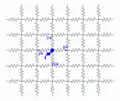 Current due to injection at any spot splits in quarters and then begins to fill the resistive grid like water filling an infinite bucket.
Current due to injection at any spot splits in quarters and then begins to fill the resistive grid like water filling an infinite bucket.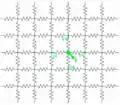 Current removed at another spot splits in quarters and then begins to drain the resistive grid like draining an infinite bucket.
Current removed at another spot splits in quarters and then begins to drain the resistive grid like draining an infinite bucket.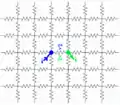 Together the two create a steady state situtation where the question "What is the input impedance" can be asked. The current i is i/4 + i/4 = i/2. v = i/2*Z so v/i = Z/2 = input impedance.
Together the two create a steady state situtation where the question "What is the input impedance" can be asked. The current i is i/4 + i/4 = i/2. v = i/2*Z so v/i = Z/2 = input impedance.
If the grid were three dimensional, the current would split into 6 equal sections, thus the input impedance would be Z/3.
So what does this mean? It helps us understand that the infinity of space has an impedance: 376.730... ohms which is plank's impedance * 4π and is related to the speed of light, the permeability of free space and permitivity of free space.
Perhaps this is related entanglement and to the trinity since:
This article is issued from Wikibooks. The text is licensed under Creative Commons - Attribution - Sharealike. Additional terms may apply for the media files.